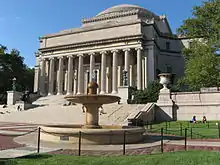Goddard Institute for Space Studies
The Goddard Institute for Space Studies (GISS) is a laboratory in the Earth Sciences Division of NASA's Goddard Space Flight Center affiliated with the Columbia University Earth Institute.[2] The institute is located at Columbia University in New York City.
 The building in which GISS is located. | |
| Founded | May 1961[1] |
|---|---|
| Founder | Dr. Robert Jastrow |
| Focus | atmospheric and climate change |
| Location | |
| Locations | |
| Affiliations | Columbia University, NASA |
| Website | www |
Research at the GISS emphasizes a broad study of global change, the natural and anthropogenic changes in our environment that affect the habitability of our planet. These effects may occur on greatly differing time scales, from one-time forcings such as volcanic explosions, to seasonal/annual effects such as El Niño, and on up to the millennia of ice ages.
The institute's research combines analysis of comprehensive global datasets (derived from surface stations combined with satellite data for sea surface temperatures) with global models of atmospheric, land surface, and oceanic processes. Study of past climate change on Earth and of other planetary atmospheres provides an additional tool in assessing general understanding of the atmosphere and its evolution.[3]
GISS was established in May 1961 by Robert Jastrow to do basic research in space sciences in support of Goddard programs.[4][5][6] Formally the institute was the New York City office of the GSFC Theoretical Division but was known as the Goddard Space Flight Center Institute for Space Studies or in some publications as simply the Institute for Space Studies. But even before it opened, the institute had been referred to in the press as the Goddard Institute for Space Studies.[7] It was separated from the Theoretical Division in July 1962. Its offices were originally located in The Interchurch Center, and the institute moved into Columbia's Armstrong Hall (formerly the Ostend apartments and subsequently the Oxford Residence Hotel) in April 1966.
From 1981 to 2013, GISS was directed by James E. Hansen. In June 2014, Gavin A. Schmidt was named the institute's third director.[8]
History of scientific research
In the 1960s, GISS was a frequent center for high-level scientific workshops, including the "History of the Earth’s Crust Symposium" in November 1966 which has been described as the meeting that gave birth to the idea of plate tectonics.[9]
At a GISS workshop in 1967, John Wheeler popularized the term "black hole" as a short-hand for 'gravitionally completely collapsed star', though the term was not coined there.[10]
In September 1974, at a seminal meeting led by Patrick Thaddeus at GISS with John Mather (his then post-doc) and others discussions began on the possibility of building a satellite to measure both the spectrum and possible spatial fluctuations of the Cosmic Microwave Background. This led directly to the COBE satellite project and a Nobel Prize for Mather.[11]
Climate change research
A key objective of Goddard Institute for Space Studies research is prediction of climate change in the 21st century. The research combines paleogeological record, analysis of comprehensive global datasets (derived mainly from spacecraft observations), with global models of atmospheric, land surface, and oceanic processes.
Climate science predictions are based substantially on historical analysis of Earth's paleoclimate (climate through geological ages), and the sea-level/ temperature/ carbon dioxide record.
Changes in carbon dioxide associated with continental drift, and the decrease in volcanism as India arrived at the Asian continent, allowed temperatures to drop & Antarctic ice-sheets to form. This resulted in a 75m drop in sea level, allowing our present-day coastlines & habitats to form and stabilize.[12]
Global change studies at GISS are coordinated with research at other groups within the Earth Sciences Division, including the Laboratory for Atmospheres, Laboratory for Hydrospheric and Biospheric Sciences, and Earth Observing System science office.
Awards
GISS Director James Hansen received the Heinz Award in 2001.
In November 2004, Climatologists Drew Shindell and Gavin Schmidt were named amongst Scientific American magazine's Top 50 Scientist award.[13]
One-time GISS post-doctoral scientist John C. Mather was years later awarded the Nobel Prize in Physics in 2006.[14]
Alumni
Notable people who have worked at GISS and their periods of employment:
- W. David Arnett, postdoc
- Alastair G. W. Cameron (1961-1966)
- Mark Cane (1966-1970, 1975-1976), programmer, postdoc
- Hong-Yee Chiu (1961-1984)
- Benjamin Cook (2001-)
- Thomas M. Dame (1983-1984), postdoc
- Anthony Del Genio (1979-2019)
- Rhodes Fairbridge (1955-2006)
- Inez Fung (1986-1993)
- James Hansen (1967-2014)
- Robert Jastrow (1961-1981)
- John Knox (1995-2001), postdoc
- Kuo-Nan Liou (1970-1972), postdoc
- John McAfee (1968-1970), programmer
- John C. Mather (1974-1976), postdoc
- Michael I. Mishchenko (1992-2020)
- Michael J. Prather (1985-1992)
- William J. Quirk, postdoc
- Cynthia E. Rosenzweig (1993-)
- William B. Rossow (1979-2007)
- Gavin Schmidt (1996-)
- Stephen Schneider (1971-1972), postdoc
- Drew Shindell (1995-2014)
- Richard Somerville (1971-1974)
- Richard Stothers (1961-2011)
- Patrick Thaddeus (1966-1986)
In popular culture
- The institute is housed at the corner of West 112th St. and Broadway in New York City in Columbia University's Armstrong Hall. The building also houses Tom's Restaurant, which was the exterior for the restaurant in Seinfeld and the subject of the Suzanne Vega song Tom's Diner.
- WQED made a documentary in the 1960s "The Universe on a Scratch Pad" about the theoretical work being done at GISS.[15]
References
- "The institute was established in May 1961, by Dr. Robert Jastrow, following its approval in December 1960 by NASA Administrator T. Keith Glennan". Retrieved 5 May 2014.
-
 This article incorporates public domain material from the National Aeronautics and Space Administration document: "Overview".
This article incorporates public domain material from the National Aeronautics and Space Administration document: "Overview".
-
 This article incorporates public domain material from the National Aeronautics and Space Administration document: "Goddard Institute for Space Studies (GISS) (611) Home".
This article incorporates public domain material from the National Aeronautics and Space Administration document: "Goddard Institute for Space Studies (GISS) (611) Home".
- R.L. Rosholt (1966). "Administrative History of NASA, 1958-1963". NASA. p. 124. NASA SP-4101.
- Homer E. Newell Jr. (1980). "Beyond the Atmosphere: Early Years of Space Science". NASA. pp. 237–239. NASA SP-4211.
- L.E. Wallace (1999). "Dreams, Hopes, Realities: NASA's Goddard Space Flight Center: The First Forty Years". NASA. pp. 24–25. NASA SP-4312.
- "Space Study Group Slated Here in May". New York Times. January 29, 1961.
- "NASA Names Schmidt Director of the Goddard Institute for Space Studies".
- "Meeting gave birth to the idea of global tectonics".
- "World Wide Words: Black Hole". World Wide Words. Retrieved 14 January 2018.
- "Patrick Thaddeus". Nature Astronomy 1, 2017, doi:10.1038/s41550-017-0170
- "James Hansen, public lecture 12th May 2011". Archived from the original on 15 May 2011. Retrieved 14 January 2018.
- Goddard Institute for Space Studies (November 9, 2004). NASA Climatologists Named in Scientific American Top 50 Scientists. Retrieved on 2008-09-25.
- "The Nobel Prize in Physics 2006" (Press release). The Royal Swedish Academy of Sciences. 3 October 2006. Retrieved 2006-10-05.
- TV, Climate Science (24 August 2012). "Universe on a Scratchpad". Retrieved 14 January 2018 – via Vimeo.
External links
- Goddard Institute for Space Studies (GISS) - Official Site
- GISS Global Surface Temperature Analysis (GISTEMP) - Global Surface Temperature Data

